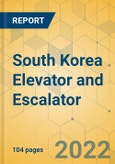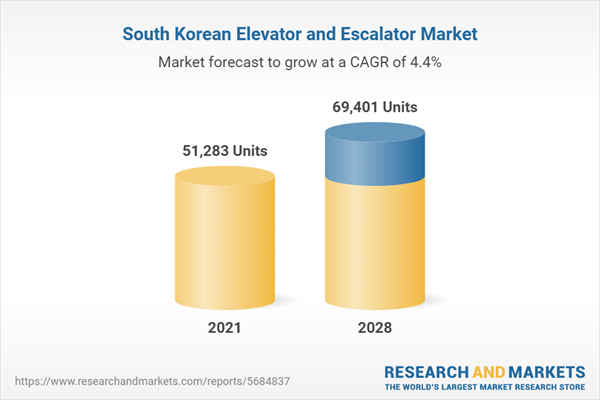Speak directly to the analyst to clarify any post sales queries you may have.
MARKET OUTLOOK
Increased urbanization, rising demand for high-rise structures, and the government's focus on infrastructure in key economic cities have propelled South Korea Elevator & Escalator business to new heights.The South Korea elevator market by the installed base is expected to reach 1 million units by 2028. The government representatives signed an agreement to boost the number of smart domestic factories, intending to have 30,000 such facilities operational nationally by 2022. By 2030, 2,000 new AI-powered smart factories are expected to be built to keep up with the Fourth Industrial Revolution's rapid advancements in automation and full digitalization. Further, the South Korea escalator market by the installed base is expected to grow at a CAGR of 5.16%. In 2021, escalators used in the commercial sector accounted for the largest share of around 52% due to the surge in smart city projects and other infrastructure development projects in the pipeline.
In the country, Digital Edge intends to expand its business substantially. Through a business partnership with local developer SK Ecoplant, the corporation will construct a 120-megawatt facility in Bupyeong-gu, Incheon. The project will start its first construction phase in 2022, and the site is anticipated to be ready for use by 2024. In 2021, Digital Edge purchased two locations from Sejong Telcom, one each in Seoul and Busan. Also, according to the Korea Elevator Safety Agency, the freight elevators increased significantly from 2020 to 2021, around 28%. With global supply chain issues, South Korea intends to set up manufacturing plants across the country, leading to increased manufacturing and industrial structures.
KEY HIGHLIGHTS
a) Ulsan's 'Industrial Complex Renovation' project aims to build a sophisticated cooperative complex. Over three years, starting from 2021, Ulsan City will contribute a net of USD 1.52 billion, comprising USD 1.5 billion from the government and USD 2.3 million from the metropolitan area, to generate 4,900 jobs and lure 4,000 mobility enterprises. It will assist 27 specific initiatives, such as developing simulated autonomous welding systems based on artificial intelligence (AI), support for the technology transformation of future automotive cabinets and electric components, and demonstration projects. These combined efforts are to provide support to the South Korea elevator and escalator market.b) According to the Ministry of Land, Infrastructure, Transport, and Tourism (MOLIT), as a part of the Fourth nationwide railway plan, the Jeolla Line, the Honam Line, and the Donghae Line will be upgraded to provide high-speed services. In addition, West Coast will have its high-speed line. Another major route includes the direct route from Gwangju to Daegu; these areas have been connected by high-speed rail. A new line from Samcheok south of the East China Sea to Yongdeok in the north of Pohang on the east coast is already under construction. This will now be upgraded to a high-speed operation from Ganggen to Pohang by 2030.
c) The construction of a new airport on Gadeok Island, the largest island in Busan, is a massive state project costing around 13.7 trillion won (USD 10.97 billion), which is intended to meet rising air traffic demand and promote development in the nation's southeast. In the southern port city of Busan, South Korea wants to construct the nation's first 'floating airport' by 2035. The new airport development will boost the South Korea elevator & escalator market growth.
SEGMENTATION ANALYSIS
Elevator Market Segmentation by
Machine Type
- Hydraulic and Pneumatic
- Machine Room Traction
- Machine Room Less Traction
- Others
- Climbing
- Elevators
- Industrial Elevators
Carriage Type
- Passenger
- Freight
Capacity
- 2-15 Persons
- 16-24 Persons
- 25-33 Persons
- 34 Persons and Above
End-User
- Commercial
- Residential
- Industrial
- Others
- Public Transit
- Institutional
- Infrastructural
Escalator Market Segmentation by
Product Type
- Parallel
- Multi Parallel
- Walkway
- Crisscross
End-User
- Public Transit
- Commercial
- Others
- Institutional Sector
- Infrastructure
- Industrial
Government Focus on Increasing the Housing Supply In South Korea To Boost Demand For The Installation of Elevators
a) The number of new construction licenses in Seoul, the capital of South Korea, increased by 52 percent to 50,638 in 2021. The number of new housing permits issued in the capital region, which includes the western port city of Incheon and the nearby province of Gyeonggi, increased by 20.2 percent year over year while it increased 23.1% elsewhere in the nation.b) Daegu received an annual allocation for smart cities of USD 17 million as part of a national innovation program. To create 'Smart Daegu,' the City's Smart City Plan (2021-2025) lays the groundwork for increasing citizen happiness and fostering local businesses boosting the South Korea elevator market.
Government's Efforts to Expand Infrastructure Across Nation To Increase Demand For New Installations
a) The Korea Institute of Ocean Science and Technology (KIOST) is conducting a USD 30.8 million project to develop an undersea living and working area for people of South Korea's southeast coast near Ulsan Metropolitan City. Additionally, the initiative will look into highly effective undersea data centers. The government is funding the 'Submarine Space Creation and Utilization Technology Development Competition Project' with 31.1 billion WON (USD 23 Million), covering more than 80% of the project's total cost. The project is expected to last five years and was announced in 2022, boosting the South Korea elevator & escalator market.b) Lotte, Shinsegae, and Hyundai are competing to be the first to build a brand-new mega-shopping center. In 2020, Human Holdings paid 685 billion WON (USD 529 Million) to acquire the facility that had been utilized as a textile factory on a plot of land covering 310,000 square meters in Buk-gu, Gwangju. The major details of the construction are not yet disclosed.
c) Despite including a railway in the Panmunjeom Declaration of 2018, the project was shelved in 2019 because of negotiations between North Korea and the U.S. aimed at peace in the region. After the South Korean government declared construction to be an inter-Korean cooperation project, work was able to resume a year later. The project could be finished as early as 2027 and is anticipated to cost roughly 2.74 trillion WON (USD 2.31 Billion).
Increasing Older Buildings and Adoption of New Technologies to Create Demand For Maintenance And Modernization of Elevators And Escalators
a) According to Seoul Energy Corporation, it has successfully secured greenhouse gas emissions through a reduction effort for the first time in Korea. The approved greenhouse gas reduction is 168 tons or savings from 177 regenerative brakes placed in 10 elevators in shared homes for around 2.5 years. It is possible to recover and use between 15 and 40 % of the electricity used by the current elevator.b) In 2018, the average time spent repairing an escalator decreased by 37 percent from 56 minutes to 37 minutes after the adoption of IoT technology for 100 escalators installed at 12 stations on Line 7. The escalators implemented with IoT are equipped with sensors that can assist and signal authorities in real-time monitoring. Such factors will boost the maintenance and moderation of the South Korea elevator & escalator market.
REGIONAL ANALYSIS
- Daegu received an annual allocation for smart cities of USD 17 million as part of a National Innovation Programme
- With a USD 4.9 trillion expenditure, Busan will host the world EXPO in 2030. With a vision of achieving a per capita income of 50,000 USD, the city will rank among the top 30 global cities in the globe. The city's employment rate will reach 70%. The city will become the third-most significant global maritime city in the world. It will improve the city's geoeconomic position as a gateway to Eurasia, further contributing to the South Korea elevator and escalator market
VENDOR LANDSCAPE
- The top 5 prominent vendors, including Hyundai, TKE, Otis, Mitsubishi, and Schindler, account for 83% of the market share in South Korea
- Hyundai’s Elevator production (Number of units) for 2021 was 25,598. The company was also certified with ISO9001(Quality management system), ISO14001(Environment management system), and ISO45001(Health safety and management)
- Over the years, Otis Elevator Company progressively increased its profile in South Korea. In 2000, it teamed up with LG Industrial Systems' lift division; in 2006, it fully acquired the business. Otis Elevator Korea operates 50 locations across the country, and the company has a presence in more than 200 countries
- From 2021 onwards, Mitsubishi aims to strengthen its purchasing structure by achieving a low-cost ratio. Materials planning offices in various regions will implement purchasing strategies and optimal procurement activities based on region
Key Vendors
- Hyundai
- Otis
- TK Elevato
- Mitsubishi Electric
- Schindler
- Fujitec
Other Prominent Vendors
- Toshiba Elevator and Building Systems Corporation
- Sigma Elevator
- Handok Elevator Co Ltd
- GYG Elevator
- Nippon Elevator
KEY QUESTIONS ANSWERED
1. How big is the South Korea elevator and escalator market?2. How many elevators and escalators were installed in South Korea in 2021?
3. Who are the key companies in the South Korea elevator and escalator market?
4. What will be the growth rate of the South Korea elevator and escalator market?
5. What are the growth factors for the South Korea elevator and escalator market?
Table of Contents
Companies Mentioned
- Hyundai
- Otis
- TK Elevato
- Mitsubishi Electric
- Schindler
- Fujitec
- Toshiba Elevator and Building Systems Corporation
- Sigma Elevator
- Handok Elevator Co Ltd
- GYG Elevator
- Nippon Elevator
Methodology
Our research comprises a mix of primary and secondary research. The secondary research sources that are typically referred to include, but are not limited to, company websites, annual reports, financial reports, company pipeline charts, broker reports, investor presentations and SEC filings, journals and conferences, internal proprietary databases, news articles, press releases, and webcasts specific to the companies operating in any given market.
Primary research involves email interactions with the industry participants across major geographies. The participants who typically take part in such a process include, but are not limited to, CEOs, VPs, business development managers, market intelligence managers, and national sales managers. We primarily rely on internal research work and internal databases that we have populated over the years. We cross-verify our secondary research findings with the primary respondents participating in the study.

LOADING...
Table Information
| Report Attribute | Details |
|---|---|
| No. of Pages | 104 |
| Published | November 2022 |
| Forecast Period | 2021 - 2028 |
| Estimated Market Value in 2021 | 51283 Units |
| Forecasted Market Value by 2028 | 69401 Units |
| Compound Annual Growth Rate | 4.4% |
| Regions Covered | South Korea |
| No. of Companies Mentioned | 11 |









